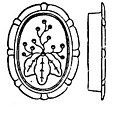File:JapanHomes107 HIKITE.jpg
From Wikimedia Commons, the free media repository
Jump to navigation
Jump to search
JapanHomes107_HIKITE.jpg (196 × 207 pixels, file size: 16 KB, MIME type: image/jpeg)
File information
Structured data
Captions
Captions
Add a one-line explanation of what this file represents
Summary[edit]
| DescriptionJapanHomes107 HIKITE.jpg |
English: From original book: "Conveniences for pushing back the fusuma are secured in a variety of ways; the usual form consists of an oval or circular plate of thin metal, having a depressed area, inserted in the fusuma in about the same position a doorknob would be with us. These are called hikite, and often present beautiful examples of metalwork, being elaborately carved and sometimes enamelled. The same caprices and delights in ornamentation seen elsewhere in their work find full play in the designs of the hikite. Fig. 106 shows one from the house of a noble; its design represents an inkstone and two brushes, — the brushes being silvered and tipped with lacquer, while in the recessed portion is engraved a dragon. Fig. 107 represents one made of copper, in which the leaves and berries are enamelled; the leaves green, and the berries red and white. Figs. 108 and 109 show more pretentious as well as cheaper forms, the designs being stamped and not cut by hand. Sometimes hikite are made of porcelain. In the cheaper forms of fusuma, the hikite consists of a depressed area in the paper formed by a modification of the frame itself. In illustrations of fine interiors one often notices a form of hikite from which hang two short cords of silk tied in certain formal ways, on the ends of which are tassels. From the almost universal presence of these in old illustrated books, one is led to believe that formerly the cord was the usual handle by which the fusuma was pulled back and forth, and that these gradually fell into disuse, the recessed plate of metal alone remaining. This form of hikite is rarely seen to-day, though a few of the old Daimios' houses still possess it. Fig. 110 represents two forms copied from a book entitled "Tategu Hinagata." " |
||||||||||||||||||||
| Date | |||||||||||||||||||||
| Source | https://www.kellscraft.com/JapaneseHomes/JapaneseHomesCh03.html | ||||||||||||||||||||
| Author |
creator QS:P170,Q2519303 |
||||||||||||||||||||
Licensing[edit]
| Public domainPublic domainfalsefalse |
This work is in the public domain in the United States because it was published (or registered with the U.S. Copyright Office) before January 1, 1929.
Public domain works must be out of copyright in both the United States and in the source country of the work in order to be hosted on the Commons. If the work is not a U.S. work, the file must have an additional copyright tag indicating the copyright status in the source country.
Note: This tag should not be used for sound recordings.PD-1923Public domain in the United States//commons.wikimedia.org/wiki/File:JapanHomes107_HIKITE.jpg |
File history
Click on a date/time to view the file as it appeared at that time.
| Date/Time | Thumbnail | Dimensions | User | Comment | |
|---|---|---|---|---|---|
| current | 01:06, 7 February 2020 |  | 196 × 207 (16 KB) | HLHJ (talk | contribs) | User created page with UploadWizard |
You cannot overwrite this file.
File usage on Commons
There are no pages that use this file.
File usage on other wikis
The following other wikis use this file:
- Usage on ja.wikipedia.org

